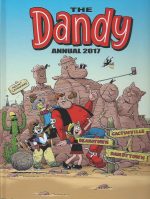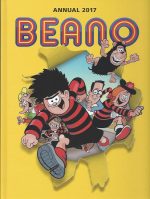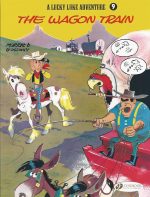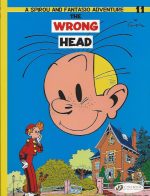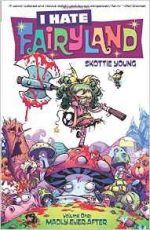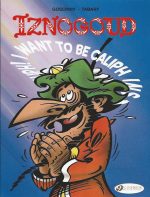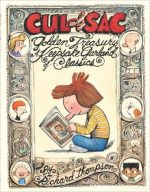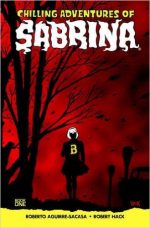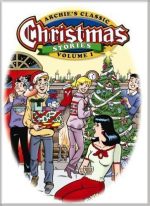
By Frank Doyle, Harry Lucey & various (Archie Comics)
ISBN: 978-1-879794-10-1
Win’s Christmas Gift Recommendation: For All Those Who’ve Been Extra Good This Year… 9/10
As long-term readers might recall, my good lady wife and I have a family ritual we’re not ashamed to share with you. Every Christmas we barricade the doors, draw the shutters, stockpile munchies, stoke up the radiators and lazily subside with a huge pile of seasonal comics from yesteryear.
(Well, I do: she also insists on a few monumental feats of cleaning and shopping before manufacturing the world’s most glorious and stupefying meal to accompany my reading, gorging and – eventually – snoring…)
The irresistible trove of funnybook treasures generally comprises older DC’s, loads of Disney’s and some British annuals, but the vast preponderance is Archie Comics.
From the earliest days this American institution has quite literally “owned Christmas†through a fabulously funny, nostalgically charming, sentimental barrage of cannily-crafted stories capturing the spirit of the season through a range of cartoon stars from Archie to Veronica, Betty to Sabrina and Jughead to Santa himself…
For most of us, when we say “comicbooks†people’s thoughts turn to steroidal blokes – and women – in garish tights hitting each other, bending lampposts and lobbing trees or cars about. That or stark, nihilistic crime, horror or science fiction sagas aimed at an extremely mature and sophisticated readership of confirmed fans.
Throughout the decades though, other forms and genres have waxed and waned. One that has held its ground over the years – although almost completely migrated to television these days – is the genre of teen-comedy begun by and synonymous with a carrot topped, homely (at first just plain ugly) kid named Archie Andrews.
MLJ were a small publisher who jumped on the “mystery-man†bandwagon following the debut of Superman. In November 1939 they launched Blue Ribbon Comics, promptly following-up with Top-Notch and Pep Comics. The content was the standard blend of costumed heroes and two-fisted adventure strips, although Pep did make a little history with its first lead feature The Shield, who was the American industry’s first superhero to be clad in the flag (see America’s 1st Patriotic Hero: The Shield)
After initially revelling in the benefits of the Fights ‘N’ Tights game, Maurice Coyne, Louis Silberkleit and John Goldwater (MLJ, duh!) spotted a gap in their blossoming market and in December 1941 the costumed cavorters and two-fisted adventurers were gently nudged aside – just a fraction at first – by a wholesome, improbable and far-from-imposing new hero; an unremarkable (except, perhaps, for his teeth) teenager who would have ordinary adventures just like the readers, but with the laughs, good times, romance and slapstick emphasised.
Almost certainly inspired by the hugely popular Andy Hardy movies, Goldwater developed the concept of a youthful everyman protagonist and tasked writer Vic Bloom & artist Bob Montana with the job of making it work. Their precocious new notion premiered in Pep #22: a gap-toothed, freckle-faced, red-headed kid obsessed with impressing the pretty blonde girl next door.
A 6-page untitled tale introduced hapless boob Archie Andrews and wholesomely pretty Betty Cooper. The boy’s unconventional best friend and confidante Jughead Jones also debuted in the first story, as did idyllic small-town utopia Riverdale. It was a huge hit and by the winter of 1942 the kid had won his own title.
Archie Comics #1 was MLJ’s first non-anthology magazine and with it began the slow transformation of the entire company. With the introduction of ultra-rich, raven-haired Veronica Lodge, all the pieces were in play for the industry’s second Genuine Phenomenon…
By 1946 the kids were in charge, so MLJ became Archie Comics, retiring most of its costumed characters years before the end of the Golden Age to become, to all intents and purposes, a publisher of family-friendly comedies. The hometown settings and perpetually fruitful premise of an Eternal Romantic Triangle – with girl-hating best bud Jughead Jones and scurrilous rival Reggie Mantle to test, duel and vex our boy in their own unique ways – the scenario was one that not only resonated with the readership but was infinitely fresh…
Archie’s success, like Superman’s, forced a change in content at every other publisher (except perhaps Gilberton’s Classics Illustrated) and led to a multi-media brand which encompasses TV, movies, newspaper strips, toys and merchandise, a chain of restaurants and, in the swinging sixties, a pop music sensation when Sugar, Sugar – from the animated TV cartoon – became a global pop smash. Clean and decent garage band “The Archies†has been a fixture of the comics ever since…
The Andrews boy is good-hearted, impetuous and lacking common sense, Betty his sensible, pretty girl next door who loves the ginger goof, and Veronica is rich, exotic and glamorous: only settling for our boy if there’s nobody better around. She might actually love him too, though. Archie, of course, is utterly unable to choose who or what he wants…
The unconventional, food-crazy Jughead is Mercutio to Archie’s Romeo, providing rationality and a reader’s voice, as well as being a powerful catalyst of events in his own right. That charming house of luurve (and annexe) has been the rock-solid foundation for seven decades of funnybook magic. Moreover the concept is eternally self-renewing…
This eternal triangle has generated thousands of charming, raucous, gentle, frenetic, chiding and even heart-rending humorous dramas ranging from surreal wit to frantic slapstick, with the kids and a constantly expanding cast of friends (boy genius Dilton Doily, genial giant jock Big Moose and aspiring comicbook cartoonist Chuck amongst many others) growing into an American institution and part of the nation’s cultural landscape.
The feature has thrived by constantly re-imagining its core archetypes; seamlessly adapting to the changing world outside its bright, flimsy pages, shamelessly co-opting youth, pop culture and fashion trends into its infallible mix of slapstick and young romance. Each and every social revolution has been painlessly assimilated into the mix and, over the decades, the company has confronted most social issues affecting youngsters in a manner always both even-handed and tasteful.
Constant addition of new characters such as African-American Chuck and his girlfriend Nancy, fashion-diva Ginger, Hispanic couple Frankie and Maria and spoiled home-wrecker-in-waiting Cheryl Blossom have contributed to a wide and appealingly broad-minded scenario. In 2010 Archie easily cleared the American industry’s final hurdle when openly gay Kevin Keller became an admirable advocate, capably tackling and dismantling the last major taboo in mainstream Kids’ comics.
One of the most effective tools in the company’s arsenal has been the never-failing appeal of seasonal and holiday traditions. In Riverdale it was always sunny enough to surf at the beach in summer and it always snowed at Christmas…
The Festive Season has never failed to produce great comics stories. DC especially have since their earliest days perennially embraced the magic of the holiday with a decades-long succession of stunning and sentimental Batman thrillers – as well as many other heroic team-ups incorporating Santa Claus, Rudolph and all the rest.
Archie also started early (1942) and kept on producing year-end classics. The stories became so popular and eagerly anticipated that in 1954 the company created a specific oversized title – Archie’s Christmas Stocking – to cater to the demand, even as it kept the winter months of its other periodicals stuffed with assorted tales of elves and snow and fine fellow-feeling…
This splendidly appealing, full-colour bonanza (recently re-released as an eBook), gathers and re-presents a superb selection of Cool Yule extravaganzas – many by the irrepressible team of Frank Doyle & Harry Lucey – from those end-of-year annuals, beginning, after a jolly, informative Foreword from Kris Kringle himself with ‘Christmas Socking!’ (Archie’s Christmas Stocking #3, 1956) wherein Betty and Veronica throw a Christmas party and convince shy Midge that she should let other boys kiss her should the mistletoe demand it…
That harmless tradition carries its own perils, however, as her possessive boyfriend Moose tends to pound anybody who even looks at her funny, but the girls think they can keep the jealous lummox leashed. They’re wrong in believing the Jock is as dumb as he looks, though…
Four tales from Archie’s Christmas Stocking #4 (1957) lead off with ‘I Pine Fir You and Balsam’ as our hero convinces Veronica’s millionaire dad to save a few bucks by cutting down his own tree rather than buy one. Mr. Lodge knows Archie of old so he only has himself to blame for the cascade of costly catastrophes that ensue…
‘Dis-Missile’ then sees Betty & Veronica intercepting their friends’ letters to Santa and unable to resist making some wishes come true whilst ‘Idiot’s Delight’ finds Betty employing devastating strategy to monopolise Archie’s attentions in the run-up to Christmas.
‘Dressed to Kill’ closes that year’s festivities with a rarely seen prose vignette with Archie’s girls hosting rival parties on the same night and re-declaring their ongoing war…
There’s a trio of strip sagas from 1958 too as Archie’s Christmas Stocking #5 provides a superb slapstick ‘Slay Ride’ wherein Archie and a borrowed horse make much manic mischief in the Lodge Mansion after which ‘Ring That Belle’ confirms the perils of eavesdropping when Betty gets the wrong idea about Archie’s surprise for Ronnie…
Following a chronological aberration to review ‘Veronica’s Pin-up Page’ from Archie’s Christmas Stocking #15 (1962) we return to 1958 for a ‘Seasonal Smooch’ crafted by Dan DeCarlo, Rudy Lapick & Vincent DeCarlo, which sees Reggie abusing mistletoe privileges with Midge and sustaining agonising consequences when Big Moose gets wise…
‘The Feather Merchant’ (Archie’s Christmas Stocking #6, 1959) finds Archie in the doghouse after trying to impress bird-collector Mr. Lodge with a shoddy and shambolic selection of Avian Xmas gifts before ‘Those Christmas Blues!’ leads off a triptych of topical tales from Archie’s Christmas Stocking #10, 1961.
Here Archie’s parents lament that they’ve been sidelined in favour of the girls in their boy’s life but have a wonderful surprise awaiting them whilst ‘Not Even a Moose’ finds Reggie playing foolish pranks on the naïve giant and discovering the danger of telling people there is such a man as Santa.
Next up is an important milestone in Archie continuity. Jingles the Elf has been a seasonal Archie regular for decades and ‘A Job For Jingles’ in ACS #10 was his debut appearance by Doyle, Dan DeCarlo, Lapick & Vincent DeCarlo with the playful imp – who cannot be seen by adults – spending his day off just like any normal lad schmoozing around Riverdale and checking out the “attractionsâ€â€¦
Christmas with the Andrews boy always leads to disaster and injury for Mr. Lodge so in Archie’s Christmas Stocking #20 (1963) he opts for ‘Escape’ to a sunny resort. Sadly, Archie’s ability to jinx the best-laid plans, like Santa Claus, knows no limits of time or distance…
Closing out this tinsel-tinged tome is ‘The Return of Jingles’ (Doyle, Dan DeCarlo, Lapick & Vincent DeCarlo from Archie’s Christmas Stocking #20, 1963), which sees the workshop elf resurface in Riverdale only to be upstaged by a brace of workbench associates who want to see for themselves how much fun humans have…
These are joyously effective and entertaining tales for young and old alike, crafted by some of Santa’s most talented Helpers, epitomising the magic of the Season and celebrating the perfect wonder of timeless all-ages storytelling. What kind of Grinch could not want this book in their kids’ stocking (from where it can most easily be borrowed)?
© 2002 Archie Comics Publications, Inc. All rights reserved.

